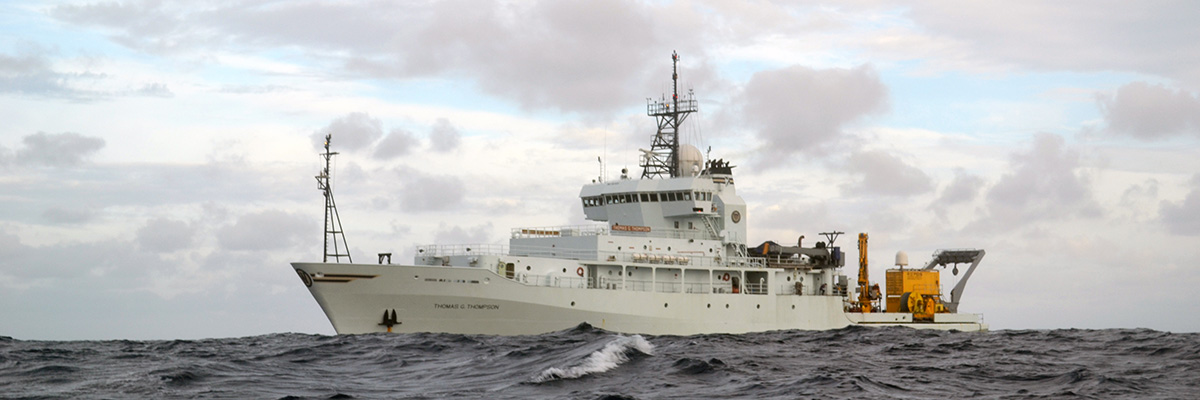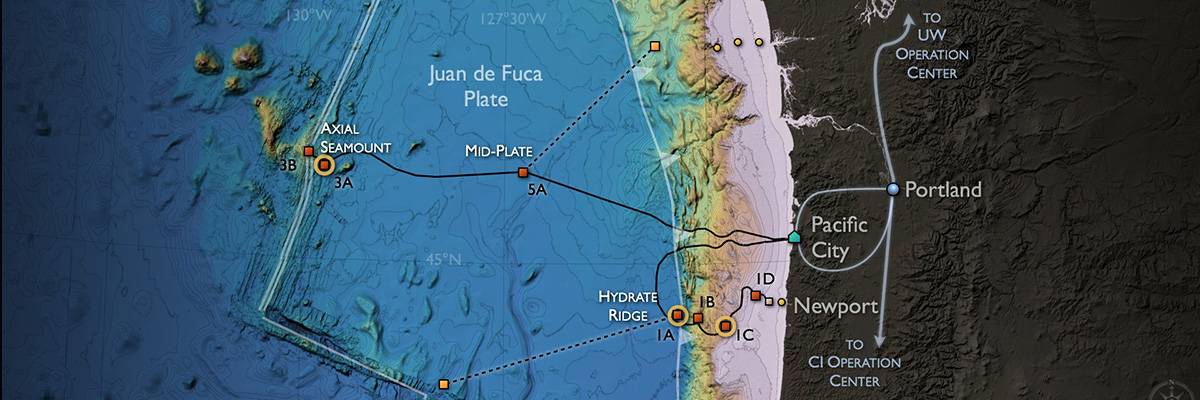VISIONS' 15 Expedition
First maintenance expedition of the Regional Scale Nodes cabled ocean observatory
For 5 weeks, we were out at sea on-board the R/V Thomas G. Thompson with the University of Washington (UW) for the VISIONS '15 expedition which ran from the 4th of July to August 7th, 2015. For our fourth year with the project, our role shifted from the installation to the maintenance of the the secondary infrastructure of the OOI Regional Scale Nodes cabled ocean observatory with the UW Ocean Observatory Initiative (OOI) team of oceanographers and engineers. On all fronts, this expedition was a resounding success and marked the first operational and maintenance expedition of the RSN's project, now called the Cabled Array. As always, CSSF and its staff enjoyed the many challenges brought forward by this ambitious project.
CSSF is proud that John R. Delaney, the Director and PI for the Regional Cabled Observatory of NSF's OOI, wrote the following about the CSSF team: "I have been working with the CSSF team for several decades, and interacting with Keith Shepherd and Keith Tamburri for more than 3 decades. I have found the level of professionalism and commitment to delivery of high quality services to be exemplary. Both the leadership and the staff members of the ROPOS operations group routinely and cheerfully give more than a 100% effort at every turn. They also have a strong tradition and commitment to safety, efficiency, training that is especially gratifying to me when we have so many students with us on our off-shore research operations." We also want to acknowledge what a pleasure and privilege it has been to work with the UW OOI team and hope that this collaboration continues to strengthen in the years to come.
By the Numbers
ROPOS performance during the expedition
98.9%
ROPOS availability
In 34 operational days, ROPOS accumulated over 134.5 hours of unused maintenance time. During the entire expedition ROPOS was available 98.9% of the time, a remarkable claim to the vehicle's reliability.
248
Hours submerged
Over 50 dives, ROPOS was submerged for 248 hours during the expedition. Taking away the time it took to travel back and forth from the seafloor, 146 hours were spent working on the seafloor.
112
instruments installed
During the expedition, 112 instruments were installed. The total number of cabled instruments from which we they are now receiving live data from the ocean is 130!
50,000
lbs of equipment
ROPOS was used to recover, deploy, and install 13 platforms on the RSN network. These junction boxes and other heavy packages were precisely positioned and oriented on the seafloor with our through-frame lift system, many others were deployed with our tool basket or belly-winch wire.
Background: The OOI RSN Project
"Launching a new era of scientific discovery and understanding of the oceans."
"The concept of a regional cabled ocean observatory--a system that would provide continuous high power and interactive real-time high-bandwidth data transfer to and from shore--began to be seriously explored by scientists at the University of Washington in the mid 1990s.
This vision carried with it solutions to some of oceanography’s most difficult challenges: how to study natural phenomena on time scales that range from seconds to decades and on spatial scales from microns to kilometers. The vision provided novel alternatives to science investigations based on limited and uncertain life spans of battery-powered instruments and on the vagaries of northeast Pacific storms that restrict ship-based expeditions to field seasons of only a few months each year.
Exciting exchanges between scientists and engineers led to a plan for a network of distributed sensors in the oceans attached to submarine fiber-optic/power cables connected to land. The fiber would provide continous power to interactive networked instrument arrays that would capture data and immediately send it to shore and onto the Internet. Such a system could encircle an entire tectonic plate and the ocean above it."
For more information, we invite you to visit the OOI RSN website: Interactive Oceans. The site contains a wealth of information on this great project as well as detailed blog entries, video highlights, and images of all of the VISIONS expeditions.
Image Credit: Interactive Oceans/UW


